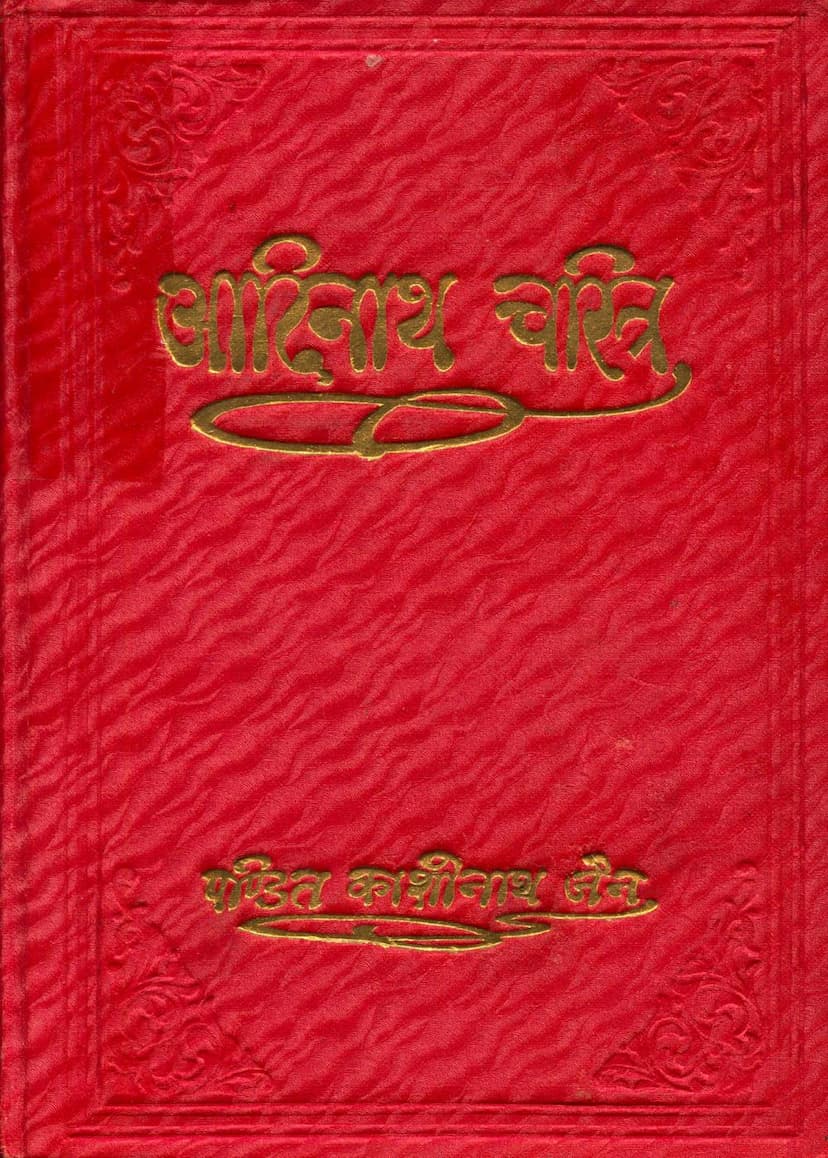Adinath Charitra
Added to library: September 1, 2025

Summary
The provided Jain text, titled "Adinath Charitra" (or Ādināth Caritra), is a Hindi translation of the first part of Hemchandracharya's renowned work, the "Trivishashthi Shalaka Purusha Charitra" (or Triṣaṣṭi Śalākā Pūruṣa Caritra). The translation was done by Pratapmuni Maharaj and published by Kashinath Jain.
Here's a comprehensive summary based on the provided text:
Introduction to Jain Literature and the Adinath Charitra:
- Four Divisions of Jain Literature: The text begins by explaining that Jain literature is divided into four main categories:
- Dravyanuyoga: Deals with philosophy and the nature of reality, including concepts of soul, six substances (dravyas), and karma. It's described as a difficult but profound branch.
- Kathanuyoga: Focuses on narratives, stories, and biographies of great souls, drawing lessons from their lives. This is considered more accessible and engaging for a wider audience.
- Ganitanuyoga: Covers mathematics and astrology.
- Charankarananuyoga: Describes rules of conduct, discipline, and related practices.
- Importance of Kathanuyoga: The "Adinath Charitra" belongs to the Kathanuyoga. The text highlights the power of stories to impart religious, philosophical, and ethical teachings. Stories are more memorable than lectures and can effectively convey complex ideas to both learned and unlettered individuals.
- Hemchandracharya: The text introduces Hemchandracharya as a prominent Jain acharya, known for converting King Kumarpal to Jainism and spreading the faith. He authored the 'Trivishashthi Shalaka Purusha Charitra' for the welfare of the world at the request of King Kumarpal. The greatness of this work is emphasized due to its author and the esteemed king for whom it was written.
- Structure of the Original Work: The 'Trivishashthi Shalaka Purusha Charitra' is divided into parts called 'Parva'. The Adinath Charitra is the translation of the first Parva, which contains six chapters (Sarga).
- The Current Translation: This particular book is the Hindi translation of the first Parva of the 'Trivishashthi Shalaka Purusha Charitra' and comprises 6 chapters.
Summary of the First Parva (Adinath Charitra):
The text then details the content of each of the six chapters of the first Parva, focusing on the life and teachings of Lord Rishabhadeva (Adinath), the first Tirthankara.
- Chapter 1 (Sarga 1): Describes the 12 bhavas (states of existence) of Shri Rishabhadeva. It highlights the religious discourse of Dharmaghosha Suri and the philosophical discussion among ministers in King Mahabal's assembly. It also mentions the acquired powers (labdhi) of the monks and the description of 20 stages of spiritual development.
- Chapter 2 (Sarga 2): Narrates the origin of the Kulakaras (lineage makers) and the story of Lord Rishabhadeva from his birth until the arising of the desire for renunciation. It includes the story of Sagarachandra (Rishabhadeva's past life), depicting the wickedness of evil-doers and the chastity and determination of a virtuous woman. It elaborates on the divine celebration of the Lord's birth, the descriptions of the Lord and Sunanda, and the joyous celebration of the Lord's marriage, including a vivid description of spring.
- Chapter 3 (Sarga 3): Covers the initiation ceremony of the Lord, his attainment of Kevala Jnana (omniscience), and his sermons.
- Chapter 4 (Sarga 4): Details the digvijaya (conquest of directions) of Bharat Chakravarti. This narrative is described as very enjoyable.
- Chapter 5 (Sarga 5): Recounts the conflict with Bahubali and includes the diplomatic mission of Suvega. It paints a vivid picture of warfare in that era.
- Chapter 6 (Sarga 6): Describes the Lord's travels after becoming Kevali (omniscient) and his nirvana (liberation) along with Bharat Chakravarti. It specifically mentions the descriptions of Ashtapad mountain, Shatrunjaya, and the palace built by Bharat Chakravarti on Ashtapad.
Key Themes and Teachings:
- Praise of Tirthankaras: The text begins with invocations and prayers to the Tirthankaras, highlighting their role as sources of glory, foundations of liberation, and rulers of the three worlds.
- Purity and Worship: It emphasizes that Tirthankaras purify beings through their names, symbols, past deeds, and current spiritual state (four nishkhepas). Their worship is encouraged.
- The Virtue of Rishabhadeva: Rishabhadeva is praised as the first king, the first renunciate, and the first Tirthankara of this epoch.
- The Power of Knowledge and Teachings: The text repeatedly mentions the impact of Tirthankaras' teachings, comparing them to sunlight on lotuses or nourishing water for plants, bringing joy and satisfaction to all beings.
- The Role of Stories in Education: The prologue strongly advocates for the use of stories in teaching religious and ethical principles, emphasizing their accessibility and effectiveness.
- Personal Dedication: The book is dedicated to the memory of Babu Lakshmichandji Karnavat.
- Call for Support: The publisher, Kashinath Jain, expresses hope that readers will embrace this work and encourage the publication of other volumes.
- Apology for Errors: Kashinath Jain acknowledges the possibility of printing errors due to visual limitations and seeks forgiveness, requesting readers to help in correcting them.
Overall Impression:
The "Adinath Charitra" aims to present the life story of the first Tirthankara in an accessible and inspiring manner. It blends philosophical concepts with captivating narratives, illustrating the Jain path to liberation through the exemplary lives of great souls. The emphasis on Kathanuyoga shows a strategic approach to religious education, making profound spiritual truths relatable and engaging for a broad audience. The detailed summary of each chapter indicates the rich narrative and doctrinal content within the first part of this significant Jain text.